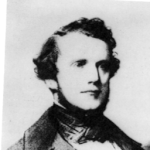Auguste Bravais
Auguste Bravais ( born August 23, 1811 in Annonay, France, † March 30, 1863 in Le Chesnay ) was a French physicist and crystallographer.
Bravais finished his classical education at the Collège Stanislas in Paris with the completion in 1827 and after a national competition in 1829, where he received the first prize in mathematics at the École Polytechnique, where he also section as one of the best. Then he could choose his future field of activity and chose the French Navy. In 1832 he was seconded to map the coast of Algeria. Publications on botany led in 1835 to his inclusion in the Philomathique Société de Paris. He received his doctorate in 1837 from the University of Lyon. Bravais undertook wide-ranging research in the fields of botany, astronomy, mineralogy and physics. In 1841 he became professor of astronomy at Lyons, in 1845 professor of physics at the École Polytechnique in Paris. There he began to deal with crystal symmetry.
Auguste Bravais 1849 showed that there are three-dimensional space 14 only elemental or unit cells of the crystal ( Bravais lattice ), which have the following properties:
In the discovery of the Bravais lattice, it had, as it turned out later, precursor in Moritz Frankenheim 1826 and Johann Hessel 1830. Bravais however, was the first who published a rigorous proof and found the wide scientific attention.
In 1866 he worked out the relationship between the ideal and the real lattice crystals. Bravais ' work were the mathematical and conceptual basis for the later discovery of the X-ray scattering experiments by Max von Laue, which led to the determination of the crystal structures 1911. Bravais In 1854 in the Academy of Sciences, but had to withdraw it due to illness from office two years.










